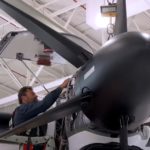The 1st Armored Brigade Combat Team, 1st Infantry Division is conducting the first soldier-operated Army Futures Command-directed Future Tactical Unmanned Aircraft System capabilities assessment.
The five-month long assessment, announced at the end of last year, will evaluate selected unmanned aircraft systems to define the capabilities needed in the next generation UAS for brigade combat teams. Data gathered during the assessment taking place at Fort Riley, Kansas, will be critical to determining the requirements for the RQ-7 Shadow replacement.
Project will assess four VTOL systems
Future Unmanned Aircraft Systems is a signature effort within the Army’s Future Vertical Lift Modernization priority. The capabilities assessment will be lead by the Program Executive Office for Aviation’s Unmanned Aircraft Systems Project Office in collaboration with Army Futures Command.
The “Devil Brigade” is the first US Army Forces Command unit to demonstrate one of the four vertical take-off and landing unmanned aircraft systems procured for the assessment.
The brigade was assigned the Arcturus UAV JUMP 20, the largest of the selected systems weighing 210 pounds with an 18-foot wingspan. Despite the size, its reduced acoustic signature compared to the Shadow was appreciated by the entire crew.
JUMP 20: less noise, half the equipment needed
“We’re used to screaming at each other and having to use radios in order to communicate,” said Spc. Christopher McCoy, a crew chief assigned to 1st Engineer Battalion, 1st Armored Brigade Combat Team. “You can stand right next to this aircraft and not even raise your voice,” he added.
Spc Nicholas Miller, an unmanned aircraft systems operator also assigned to 1st Engineer Battalion added that the JUMP 20 maintained the ability to launch and recover from a confined area with minimal ground support equipment. “Currently, we need a runway for launch and recovery of the Shadow. With the VTOL system on the JUMP 20, we don’t need any of that, we’re working with half the equipment.”
The army found the extended endurance of the system allowed multiple operators to take turns training on the payload at altitude, while a second aircraft conducts repeated launches and recoveries to train operators and crew chiefs on critical modes of flight.
System will temporarily replace RQ-7 Shadow
Over the next four months, the Big Red One Soldiers will operate the system as a surrogate for their RQ-7 Shadow, performing similar tactical tasks for the BCT, but with the added vertical take-off and landing capability and control while on the move. The assessment utilises a crawl, walk, run mentality, progressing through operator and collective training, then culminating in brigade level field training exercises and a Combat Training Center rotation.
FINN editor-in-chief Alan Peaford caught up with California-based Arcturus UAV’s VP Business Development, Philip Mayhill to learn more about the drones, which had been offered to the US Military before the assessment trials began. Mayhill ran through the highlights of the UAV’s capabilities which include 14 hours’ endurance and a 20lb payload capability.
An increase in restrictions due to COVID-19 lead to uncertainty over the schedule of the assessment but Maj Gen John Kolasheski, commanding general of the 1st Infantry Division, determined it could go ahead assessment with proper mitigations. The Army is following CDC and DoD guidelines to combat the spread of COVID-19.
The four other FORSCOM units participating in the assessment are assigned the Martin V-Bat, Textron Aerosonde HQ, L3 Harris FVR-90, and a second Arcturus UAV JUMP 20 are scheduled to begin in the coming months. These assessment schedules are under regular re-evaluation as COVID-19 conditions change.
Photo: Program Executive Office Aviation

